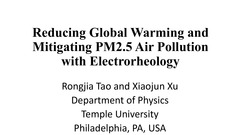Reducing Global Warming and Mitigating PM2.5 Air Pollution With Electrorheology
Rongjia Tao and Xiaojun Xu
Department of Physics, Temple University, Philadelphia, PA 19122, USA
Black carbon, a part of harmful PM2.5 air pollution, is the second largest contributor to global warming and climate change. Each year carbon dioxide adds heat density 1.56 watts/m
2 to earth surface, while black carbon adds additional heat density 1.1 watts/m
2. Moreover, according to World Health Organization (WHO), outdoor PM2.5 air pollution kills an estimated seven million people worldwide every year. Unfortunately, the current existing technologies are unable to catch black carbon particles effectively and cannot be adapted by large factories to prevent emission of black carbon particles into air. Therefore, a new technology, which can catch black carbon and other PM2.5 pollution effectively, is critically needed. Here we report that electrorheology can effectively catch all PM2.5 particles, including black carbon particles. Under a strong electric field, black carbon and other PM 2.5 pollution particles are polarized. The attractive force between polarized particles and their dipolar images is much stronger than the gravity force if the electric field exceeds 10kV/cm and the particles are close to the electrodes. The crucial issue is to make the polluted air flow become a special non-laminar flow with pollution particles moving adjacent to the electrodes. In this way, the black carbon and other PM2.5 particles are captured by the electrodes effectively. Our lab tests have confirmed that with this technology, more than 98% black carbon and other PM2.5 particles in air can be captured. In addition, this technology is not only suitable for incoming air filters, but also appropriate for large factories in preventing emitting PM2.5 pollution into the atmosphere because it allows high air flow. We hope very much that this ER technology will greatly help to improve our environment and reduce global warming.
Email address: Rongjia Tao (
rtao@temple.edu), Xiaojun Xu (
xiaojun@temple.edu)


Comment submit